Understanding The Difference in Displacement and Distance in Physics
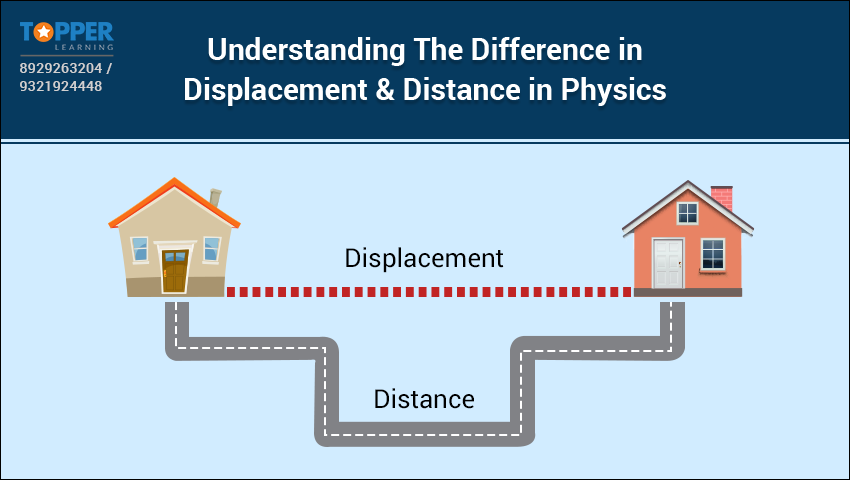
In this blog, we will explore the meaning of displacement, which is more than just measuring the path covered by an object. Moreover, with the help of examples, we will discover the fascinating truth behind the concept of displacement.
By Topperlearning Expert 01st Apr, 2024 | 03:04 pm
SharePhysics is the study of fundamental laws related to matter and energy. In our daily activities, we come across many fascinating concepts that control our motion and position on this planet and one such significant concept is displacement.
Displacement is a term different from the distance travelled by an object or a body. It analyses the change in an object's position. In this blog, we will solve the major complexities of displacement in physics, explore its definition, significance and also its real-life applications.
Defining displacement
Displacement is the shortest distance between two positions of the object from the initial to the final position during the given interval of time.
For example:
Imagine you start at point A and move to point O and then to point B. The displacement is the straight-line distance and direction from A to B, regardless of the path you took in between.
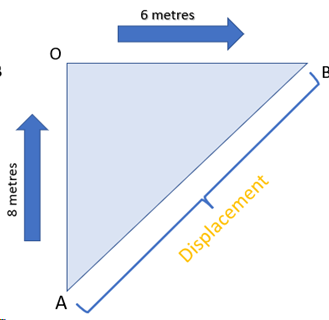
AB is the straight line joining the initial and final position of your journey.
Thus,
AB is the displacement.
By Pythagoras theorem,
AB2 = AO2 + OB2
⟹ AB2 = 82 + 62
⟹ AB2 = 64 + 36
⟹ AB2 = 100
⟹ AB = 10

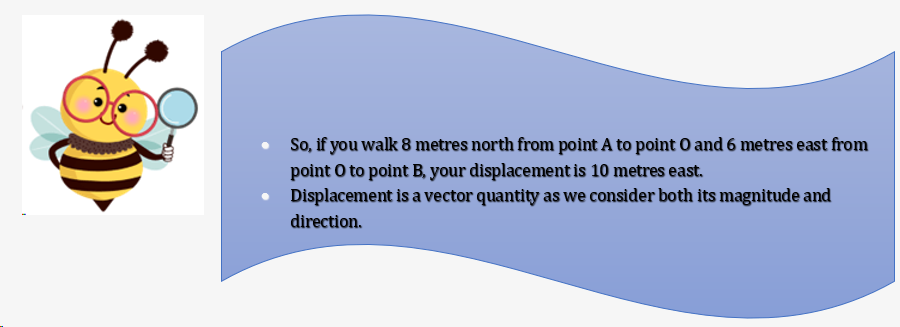
Significance of Displacement
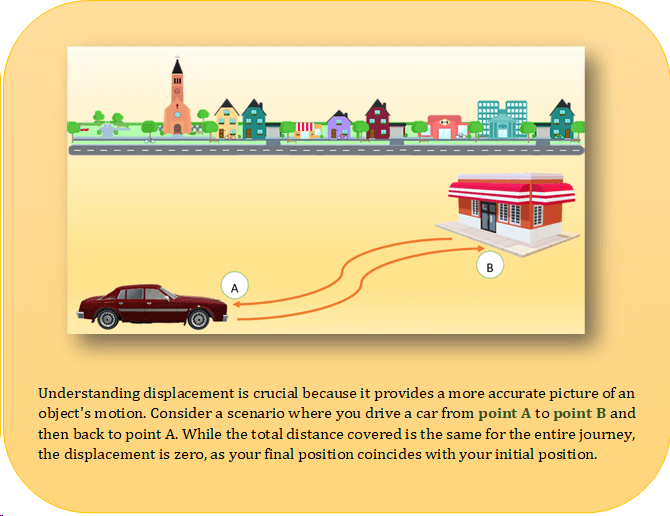
Understanding the difference between distance and displacement:
Let's explore some more real-life examples which will help us in understanding the concept of displacement:
- Girl in a Maze Game: A girl finds herself in a challenging maze game with twists and turns. After navigating through the maze, she realises her displacement is the distance from where she entered to where she exited, not the total distance she walked along the maze's winding paths. Here, displacement is about the direct escape route you took (blue arrow), not the adventure within (yellow arrows).
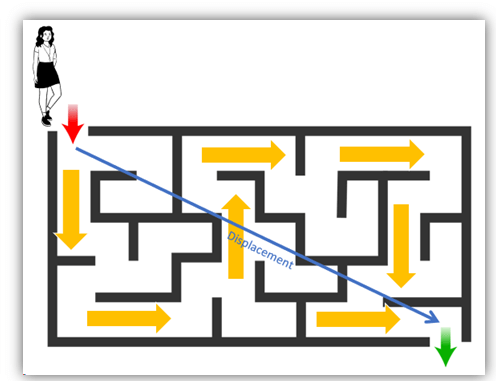
- Hiking Adventures: Imagine hiking up a mountain and then descending along a different path. Your total distance hiked is the sum of the ascent and descent, but your displacement is the straight-line distance from the base to the summit. Displacement helps us understand the net change in position, independent of the path taken.
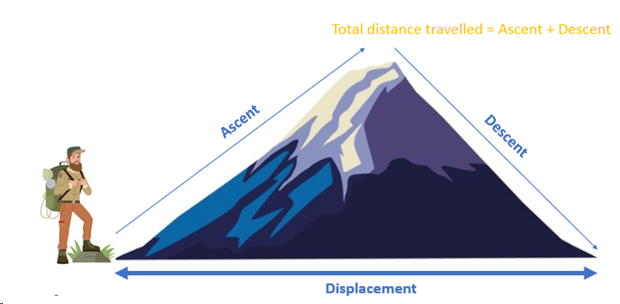
- Two Ants and the Picnic Basket: Picture a picnic where two ants are trying to reach the delicious food in a basket. Ant A takes a straight line directly to the feast, while ant B explores a winding path to the basket. The displacement is the straight-line distance the first ant travels, not the meandering journey of the amt B.
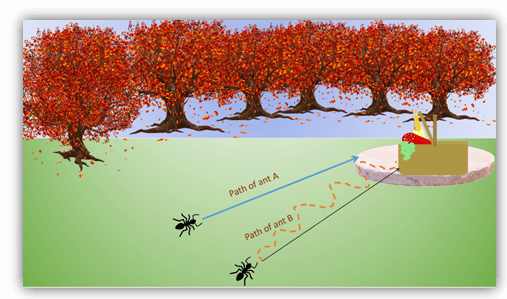
-
Distance and Displacement in the circular path:
Ferris Wheel Ride: From Sky-High to Down Low - Distance v/s Displacement!
Imagine you are floating in one of the capsules on a huge Ferris wheel, feeling on top of the world. As the wheel starts its magical spin, you are in for a gravity-defying adventure that will have you giggling with glee and learning about the cool concepts of distance and displacement!
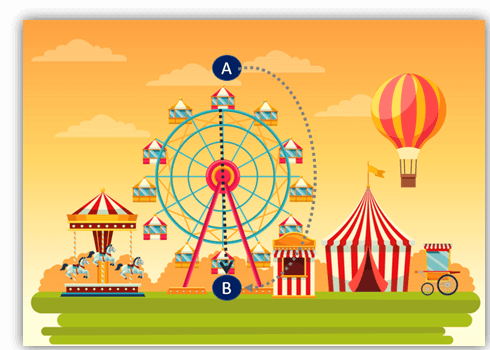
Now, here's the real magic. Imagine you have a secret teleportation power like that of Peter Parker from Spiderman and Boom! You zip straight from the tippy-top (let's call it Point A) to the very bottom (that's Point B). The displacement is like drawing an invisible line from where you started to where you ended up. And guess what? The invisible line (marked black arrow in the image) is the diameter of the Ferris wheel! So, even if you had a magical shortcut from the top to the bottom, your displacement would always be the diameter. So, imagine it this way the Ferris wheel has a secret tunnel from sky to ground which will make its journey short and sweet!So, in the Ferris wheel ride, distance is all about the sinking feeling in the stomach, laughter, spins and the joy of going around (marked by a curved grey arrow). While the displacement is like having a superpower that lets you take the quickest route i.e., a straight line from the highest point to the lowest point. And this superpower would have turned the carnival ride into a straight-up adventure! So, the next time you are on a Ferris wheel, remember that it is not just about going round and round in circles but also about the thrill of reaching the bottom in the fastest possible way.
Conclusion:
In this blog, we covered the concept of displacement in physics, which helps us understand how things move. Instead of just looking at the distance something travels, displacement also shows us how its position changes over time. Think of it as getting to know the real story behind an object's motion.
To put it in simpler words, displacement not only describes how far an object or body went but also in what direction and how it got there. All the everyday examples, like your trips or exciting hikes, helped us understand the difference between distance and displacement and how all things in the surroundings move.
TopperLearning provides all crucial resources necessary for brushing up on the concepts to have a better understanding of this and the related topics on motion. Also, you can find chapter-wise content according to the latest ICSE Class 10 syllabus. Be it concise Physics solutions for the Selina textbook or previous years’ solved ICSE question papers. Visit the ‘Ask a Doubt’ section to ask questions or view answers to questions asked by other TopperLearning student users.
Frequently Asked Questions (FAQ's):
Q 1. Why is displacement important?
Ans: Displacement is important because it gives information about changes in the position of an object by taking both direction and magnitude into consideration. Unlike distance, which measures only the length of the path travelled, displacement considers the starting and ending points of the journey. Thus, displacement is a more insightful quantity that helps in understanding the motion of an object.
Q 2. What are the units of displacement?
Ans: The units of displacement and distance are the same. Their SI unit is metre (m). They are also expressed in terms of other units like kilometres (km) or centimetres (cm). However, as displacement is a vector quantity, it also includes a direction component, making it necessary to specify both the magnitude and the direction, for example, "36 meters east” where 36 metres is the magnitude and east is the direction.
Q 3. How is displacement different from distance?
Ans: Distance is the total length of the path covered by an object during its motion, irrespective of direction. On the contrary, displacement is the vector quantity that represents the change in the position of the object considering both the magnitude as well as direction. Displacement is a more comprehensive quantity, which provides information about the final position relative to the initial position of the object.
Q 4. How to calculate displacement?
Ans: Displacement is not necessarily equal to the total distance covered by an object. Displacement is just the difference between the final position and the initial position. Thus, displacement can be calculated using the formula:
△ x = xf – xi
where:
xf -> final position
xi -> initial position
Q 5. If the displacement of a body is zero, is it necessary that the distance covered by it is also zero?
Ans: If the object is moving in a circular path, let us assume it started from a point and after one complete revolution, it reached the same point. In this case, displacement is zero but the distance covered is 2πR (circumference of the circular path), where R is the radius of the circular path.
If the object starts from a point, travels some distance and comes back to the same point then in this case, displacement is zero but the distance covered is not zero.
More from Education
Important Resources
- Education Franchisee opportunity
- NCERT Solution
- CBSE Class 9 Mathematics
- NCERT Solutions for class 10 Science
- Sample Papers
- CBSE Class 9 Science
- NCERT Solutions for class 10 Maths
- Revision Notes
- CBSE Class 10 Hindi
- CBSE Class 10 English
- CBSE Class 10 English
- CBSE Class 10 Social Studies
- CBSE Class 10 Science
- CBSE Class 10 Mathematics
- Career In Science After 10
- Career In Commerce After 10
- Career In Humanities/Arts After 10
- NCERT Solutions for Class 10
- NCERT Solutions for Class 11
- Business Studies Class 12 CBSE project





